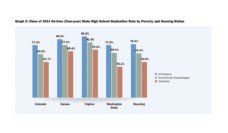Every child relies on a strong family network to succeed in school, but the effects of not having that network impacts minority and White children differently.
Historically, America has prioritized the married, two-parent household. Research on childhood education outcomes similarly find value in these family arrangements. Less is known about other “non-standard” family models, such as single parenting, living with extended family, or cohabiting households. And much of childhood educational research does not consider race, obscuring the specific experiences of minority communities.
Using national longitudinal data, Dr. Christina Cross found the effects of non-standard family structure on high school completion are different among racial and ethnic groups. She found that on-time high school completion rates differ between Black (~77%) and White children (~85%) living with both biological parents.
But there are no racial gaps among children growing up in single-mother households. White students’ on-time high school completion rates steeply decline as time spent with a single mother increases; Black children saw subtler declines. There are nearly identical rates (~58%) of on-time high school completion for Black and White children who spend their entire life with a single mother.
The results showed socioeconomic lack explained nearly 50% of the difference in how Black and White educational attainment rates differ with familial instability.
To measure why Black high school completion rates seemed less affected by family instability, Dr. Cross tested two potential explanations: socioeconomic stress and extended family embeddedness. The results showed socioeconomic lack explained nearly 50% of the difference in how Black and White educational attainment rates differ with familial instability.
Socioeconomic stress theory claims that, for marginalized communities, persistent material lack necessitates building consistent coping mechanisms. Having these coping mechanisms is thought to limit the impact of additional stressors, like family instability, for minority families compared to White families with less-tested coping strategies.
Education is a vital predictor of income, job security, and health status. The researchers suggest policies attempting to close well-documented gaps in education needs to target systems of inequity such as residential segregation and the concentration of educational resources in wealthy neighborhoods. For Black children, the idealized American nuclear family is not enough to overcome the presence of racially motivated disadvantage.
Databyte via Cross, Christina J. “Racial/Ethnic Differences in the Association Between Family Structure and Children’s Education.” Journal of Marriage and Family, vol. 82, no. 2, 2019, pp. 691–712.














